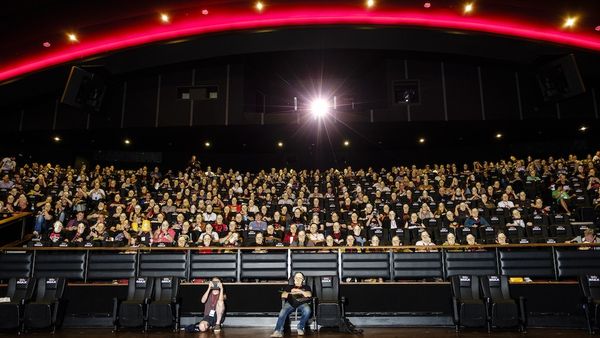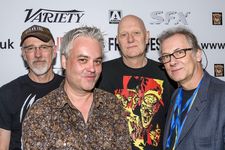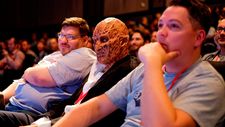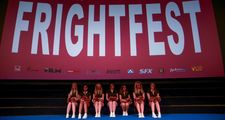 |
| Frightfest: Beneath The Dark Heart Of Cinema |
We cover a lot of festivals here at Eye For Film. Frightfest is far from the biggest, but it has long been one of the most popular. Fans of the festival and people curious to know why it makes such an impact will be pleased to hear that there’s now a documentary on the subject - Frightfest: Beneath The Dark Heart Of Cinema. It was made by Chris Collier, whom I caught up with during this year’s festival to ask how it came about.
“I’ve known the guys for a long time,” he says. “I’ve worked with them at the festival since 2011. I’ve obviously seen their relationship and their relationship with the fans, and I and my production partner [Craig Ennis] just thought that there was a story there... We thought we could tell it in an honest way, rather than it just being a puff piece.
“I’ve produced all their video content since 2011 at the festival, so we’ve shot interviews lots of times over the years and worked closely with them, so I’ve seen some of the ups and downs and how difficult it is for them to run a festival when it initially was just them running it.”
 |
| The gang's all here - behind the scenes with the Frightfest directors |
Given that close involvement, was it difficult to get the distance needed to approach the film objectively?
“It wasn’t difficult to do it, it was difficult to sit down and view it. Because all the time you’re sat down and you’re working through it, you think oh yeah, that’s fine, we’re going to be totally honest about this, and then we obviously finished the film and took it to screen it to them, so there was just me and them, and then you realise the reality that one or another is not going to like what one or another has said about them – but to their credit, they haven’t asked me to change one thing.”
Early on in the film, we hear about the conflicts between the guys who run it. Did he see potential in that, as a storyteller?
“I think that’s part of it for me. It’s these four characters that really would not get on, but the choices that they make around the films that they show, the decisions they make about how the festival has to be run, a lot of those decisions relate to how the fans feel about things. I think it is their uniqueness and that conflict that makes something special.”
How long did it take to actually shoot the film?
“We started shooting in 2016, in August – we began shooting when they were in Shepherd’s Bush, so, yup, just over two years.
“During the editing process we went back over everything that we had access to, adding anything that we felt worked well with the story. There were a few pieces that we hadn’t got that we managed to track down. There was hundreds of hours of festival footage, most of which didn’t actually need watching again because before anything goes out I see it anyway... There are pieces that we’ve used of the guys onstage that we watched absolutely every piece so it was a long job.”
There are dozens of great stories out there about Frightfest. How did he decide which to include and which to leave out?
 |
| Faces in the crowd at Frightfest |
“That was difficult,” he says. “The film was a lot, lot longer to begin with and had a lot more anecdotes in, but as we began to bring it down in length, the idea had always been that we wouldn’t talk about a specific element of the festival in the place you’d think that it would be spoken about. You know, we might talk about a particular director or the way that you can just walk up and talk to anybody at the festival, but we wanted those stories to just come naturally out of what we were talking about.
“There were specific things that were part of the story of the festival so we wanted to make sure we included those but, yeah, your question was which ones to leave out, and it was very, very difficult. There were some pieces that, at first, I really didn’t want to lose, about specific directors and their films, and films that have had a lot of impact on people, but that’s why you have an editor, who could force me to go ‘You really need to think about why that bit’s needed.’ It was very important, I think, that we set out to make something that was about 90 minutes and no more, and that moved along quickly.”
And how did he decide who to interview?
“Again, that was difficult. I had a production manager [Phil Newton] who is one of the people in the film. There were obviously people that I knew, and then we went to other people... It really was a case of, without even talking to them, trying to whittle it down to people that might have a story, and then interviewing them.
“Some of the things that we got that are in the film are just absolutely fantastic. I chose the people but I didn’t know they were going to come out with that story. There are so many people we could have chosen, but I’m really pleased with the ones that we did.
 |
| A big cheer for Frightfest |
“When you’re setting out to make a documentary you know the facts which shape the story but you need to make sure you get somebody to say that, because if nobody says it, it’s not in the film. I had to make sure that I covered the story, which I could do because I’d done all the research for that in advance, and then there were specific things in the script that I knew I would want to cover. As for the films – because we talk about several individual films – I went to the guys running the festival and I asked them about every single film they’d ever played. So that was a long interview. Just in case I missed something about a screening or something that was special.”
Finally, what are the films he’s most enjoyed seeing at the festival?
“The screenings that I remember the most are, when I first came to Frightfest, the screening of Dario Argento’s Giallo, which, of course, is mentioned it the film. It was a phenomenal, uh... it was just an incredible experience.” He laughs. “It brought out some of the fun of the festival. Also from that time, The Human Centipede, which hadn’t played anywhere. Getting to see that for the first time with that crowd was great.”
Chris is now moving on to make a documentary on a subject unrelated to horror, but, as is so often the case with these things, he’s not at liberty to talk about it, so I let him get back to the festival.





















